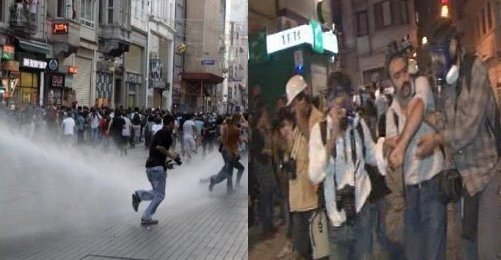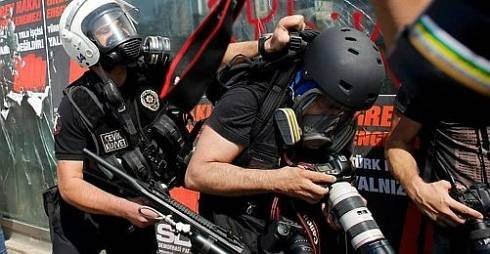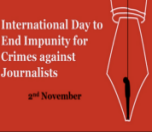MURDERED JOURNALISTS AND IMPUNITY
20 Journalists 20 Stories


They always felt nervous while they were out in the field. They could have been kidnapped, vanished or killed.
They always received death threats, notes saying that "their pencils will be broken". They were many times told to "yield in".
They didn't. And they were murdered.
After being killed, their souls couldn't even rest in peace, no need to mention their graves and families. The majority of 20 investigations remained "unsolved". Some investigations resulted with the arrest of "who pulled the trigger", but they never found the real responsible. bianet series is departing from this point of view.
Why "Murdered Journalists and Impunity"?
Committee to Protect Journalists declared November 23 to be ”Global Day to End Impunity" after the shooting death of radio journalist Julius Cauzo. Member of International Freedom of Expression Exchange, bianet has been campaigning against impunity in the fields of press freedom and free speech.
In a country like Turkey where the sense of impunity has engraved deeply into our lives, we have crafted this series in order to commemorate the murdered journalists and help to reignite the legal process.
Hard job to determine the profiles
Starting our project in September, we first headed to journalist associations to browse lists of "murdered journalists". We skimmed through a total of 140 profiles from the lists of Turkish Journalist Association and Contemporary Journalist Association, and finally forming our list of 29 journalists murdered between 1990 and 2007.
Throughout our research, we were unable to gather information on 7 profiles (Ruhi Can Tul, Mehmet Topaloğlu, Mecit Akgün, İsmail Ağaya, Muzaffer Akkuş, Yaşar Aktay and Yahya Orhan) and relate 3 profile's murder cases (Kamil Koşapınar, Ercan Gürel ve Rıza Güneşer) to their profession.
We also added some profiles in our list later on. We learned about the murder of Yaşar Parlak whose name never existed under any association listing.
20 names, 40 witnesses, hours of interviews
This is how we came up with our list of 20. We reached these murdered journalists' relatives, lawyers--a total of 40 people. We also asked for help from impunity researchers and people who witnessed the era of murders.
The most challenging part of working on this project was to remind all the events to the beloved ones to murdered journalists. Another challenge was determining the current juridical status of murder cases, most of which were no longer active nor followed through.
Impunity after all
During our investigation, we learned that 9 cases were already declared as "unsolved" with the risk that the statute of limitations are soon to run out.
In addition, Hezbollah was linked with 6 journalists' killers, some of them being prosecuted for being a "terrorist" rather than killing a journalist. Few murderers received sentences while some might have been killed by the organization.
It is important to note that a number of suspects from Hezbollah Case were released in 2011, according to a precautionary measure in the Criminal Prosecutions Law. The suspects were no longer to be found 11 days after their release, when another court ruled their arrest.
In some cases, the sense of impunity remained even though the murderers were captured. For example, the murderer of Musa Anter, currently under arrest, is still waiting for a trial. In Uğur Mumcu, Metin Göktepe and Hrant Dink cases, some murderers were prosecuted but investigations returned no results of the names behind the death order.
Our goal is...
Departing from the notion of impunity, our research is aiming to bring a new awareness to these "unsolved" murders, engender discussions and explore the possibility of reigniting the legal processes.
We undesire to see these cases being forgotten and impunity encouraging future journalist killings.
Acknowledgements
Only a collective work could have realized the "Murdered Journalists and Impunity" series.
Starting from Özgür Gündem and DIHA, we acknowledge all journalist associations, lawyers, senior journalist, human rights defenders, journalists' relatives, Human Right Association members and Friedrich Ebert Stiftung Association for their help.
We are also grateful to our intern reporters at bianet who helped us decode the recordings, search photos and find necessary phone numbers, amid all the chaos of a newsroom. (EG/BA)
JOURNALIST'S GEZI LOG
"Assault, Detention, Resignation, Unemployment"

BIA MEDIA MONITORING JULY-AUGUST-SEPTEMBER 2013
Journalists and Media Gripped By Government-Police

BIA MEDIA MONITORING APRIL-MAY-JUNE 2013
#Resist Press Freedom!

BIA MEDIA MONITORING JANUARY-FEBRUARY-MARCH 2013
Happy May 3 With All Jailed Journalists!

BIA Media Monitoring 2012 / Full Text






